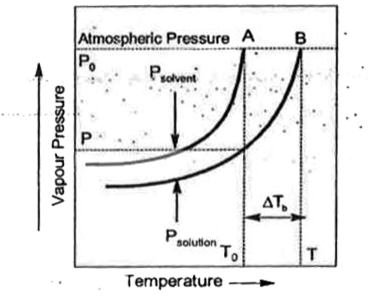If the solution boils at a temperature T1and the solvent at a temperature T2 the elevation ofboiling point is given by
T1+T2
T1−T2
T2−T1
T1+T2
The correct Answer is:B
Solution always boil at higher temperature
T1−T2=ΔTb
Topper's Solved these Questions
Similar Questions
If the solution boils at a temperature T1 and solvent at a temperature T2 the elevation of boiling point is given by:
View SolutionConsider following figure and answer the questions at the end of it. Figure explains elevation in boiling point when a non-volatile solute is added to a solvent.

Variation of vapour pressure with temperature and showing elevation in boiling point.
Given that ΔTb is the elevation in boiling point of the solvent in a solution of molality m then Ltm→0(ΔTbm) is equal to
View Solution
Knowledge Check
If the solution boils at a temperature T1 and solvent at a temperature T2 the elevation of boiling point is given by:
AT1+T2BT1−T2CT2−T1DT1÷T2If the solution boils at a temperature T1 and solvent at a temperature T2 the elevation of boiling point is given by:
AT1+T2BT1−T2CT2−T1D(T1/T2)Statement-1 : In binary ideal solution more volatile component boils at less temperature and less volatile component boils lat high temperature than their normal boiling point of pure component.
Statement-2 : For any composition, mixture boils at temperature in between their normal boiling point temperature of pure component.AStatement-1 is True, Statement-2 is True, Statement-2 is a correct explanation for Statement-1.BStatement-1 is True, Statement-2 is True, Statement-2 is NOT a correct explanation for Statement-1.CStatement-1 is True, Statement-2 is False.DStatement-1 is False, Statement-2 is True.
Figure explains elevation in boiling point when a non-volatile solute is added to a solvent. Variation of vapour pressure with temperaure and elevation in boiling point is marked.

Given that ΔTb is the elevation in boiling point of the solvent in a solution of molarity m then limm→0(ΔTbm) is equal to:
View SolutionConsider following figure and answer the questions at the end of it.
Figure explains elevation in boiling point when a non-volatile solute is added to a solvent.

Variation of vapour pressure with temperature and showing elevation in boiling point.
Given that ΔTb is the elevation in boiling point of the solvent in a solution of molality 'm' then Ltm→0(DηlTbm) is equal to
View SolutionConsider following figure and answer the questions at the end of it. Figure explains elevation in boiling point when a non-volatile solute is added to a solvent.

Variation of vapour pressure with temperature and showing elevation in boiling point.
Given that ΔTb is the elevation in boiling point of the solvent in a solution of molality m then Ltm→0(ΔTbm) is equal to
View SolutionConsider following figure and answer the questions at the end of it. Figure explains elevation in boiling point when a non-volatile solute is added to a solvent.

Variation of vapour pressure with temperature and showing elevation in boiling point.
Elevation in boiling point of an aqueous urea solution is 0.52∘.(Kb=0.52∘mol−1kg). Hence, mole fraction of urea in this solution is:
View SolutionConsider following figure and answer the questions at the end of it.
Figure explains elevation in boiling point when a non-volatile solute is added to a solvent.

Variation of vapour pressure with temperature and showing elevation in boiling point.
Elevation in boiling point of an aqueous urea solution is 0.52∘. (Kb=0.52∘mol−1kg). Hence, mole fraction of urea in this solution is
View Solution
